ASTA Excited About Field Crop Seed Conference
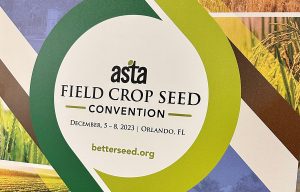 Registration is underway for the event formally known as CSS & Seed Expo and the American Seed Trade Association (ASTA) is excited about the newly named Field Crop Seed Convention to be held December 5-8 at the Hyatt Regency Orlando.
Registration is underway for the event formally known as CSS & Seed Expo and the American Seed Trade Association (ASTA) is excited about the newly named Field Crop Seed Convention to be held December 5-8 at the Hyatt Regency Orlando.
“We see really strong participation numbers in our registration, outpacing where we have been in previous years,” said ASTA President and CEO Andy LaVigne. “The expo floor is nearly two-thirds sold out.”
LaVigne says it is bitter sweet to not be meeting in Chicago after more than 75 years in that location, but Orlando has lots of great advantages in the weather and local attractions, and the convention layout will offer new opportunities for people to network. “We’re going to have a larger expo floor, a lot of the traffic going to any of the sessions will just about have to go through the expo floor,” he said. “That ability to see people and run into them easily is exciting for us.”
LaVigne says the conference will still include the same great educational opportunities as always, including the annual economic outlook for agriculture by analyst Dan Basse. The conference is expected to draw around 2,000 attendees from 36 countries, working in all field crops, from corn and soybean, to wheat, rice, cotton, sorghum and more.
In this interview, LaVigne talks about what to expect at the conference, as well as the big issues ASTA is watching, including the farm bill negotiations.
ASTA Field Crop Seed preview interview with Andy LaVigne 11:37USDA Adjusts Yields in August Report
 USDA’s first survey-based forecasts for the season slightly lowered yields for corn and soybeans compared to projections last month.
USDA’s first survey-based forecasts for the season slightly lowered yields for corn and soybeans compared to projections last month.
In the August Crop Production report released Friday, USDA puts corn production for 2023/24 at 15.1 billion bushels, down 209 million from the July projection, but ten percent more than 2022 which would be the second highest on record behind 2016/17. The corn yield forecast, at 175.1 bushels per acre, is 2.4 bushels lower than July’s forecast. The report indicates that among the major producing States, yields are forecast above a year ago in Indiana, Iowa, Nebraska, Ohio, and South Dakota. Yields in Illinois, Minnesota, and Missouri are forecast below a year ago.
The USDA World Agricultural Supply and Demand Estimates for August, also released on Friday, cuts total U.S. corn use for 2023/24 by 95 million bushels to 14.4 billion with feed and residual use lowered 25 million bushels while corn use for ethanol remained the same at 5.3 billion.
Soybean production for 2023/24 is forecast at 4.2 billion bushels, down 95 million from July on lower yields and down
2 percent from 2022. Harvested area is forecast at 82.7 million acres, unchanged from July. The first survey-based soybean yield forecast of 50.9 bushels per acre is reduced 1.1 bushels from last month. If realized, the forecasted yields in Arkansas, Indiana, Mississippi, North Carolina, Ohio, and South Carolina will be record highs.
Wheat production is forecast at 1.73 billion bushels, up 5% from 2022. Growers are expected to produce 1.23 billion bushels of winter wheat this year, up 2% from the previous forecast and up 11% from last year. Durum wheat production is forecast at 57.4 million bushels, down 10% from 2022. All other spring wheat production is forecast at 450 million bushels, down 7% from last year. Based on Aug. 1 conditions, the U.S. all wheat yield is forecast at 45.8 bushels per acre, down less than one bushel from 2022.
Today’s report also included the first NASS production forecast of the season for U.S. cotton. NASS forecasts all cotton production at 14.0 million 480-pound bales, down 3% from last year. Yield is expected to average 779 pounds per harvested acre, down 171 pounds from 2022.
Industry Ag News 8/11
Wyant Receives Communication Excellence Award
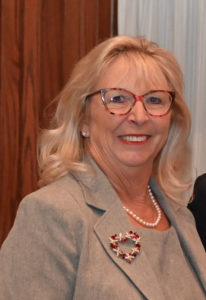 Congratulations to Sara Wyant, president and CEO of Agri-Pulse Communications, who recently received the Rueben Brigham Award.
Congratulations to Sara Wyant, president and CEO of Agri-Pulse Communications, who recently received the Rueben Brigham Award.
The award is given by the Association of Communication Excellence (ACE) to a communicator who has made a major contribution in the field of agriculture, natural resources, or life and human sciences. The award is named after Reuben Brigham (1887-1946) who served as an Extension editor and 4-H club agent in Maryland and was called to the Federal Extension Service office in 1917 to develop an editorial and visual aids service for Extension editors.
The Reuben Brigham award was a pleasant surprise for Wyant, and she was proud to be a recipient. “I was really delighted to be honored by an association that does so much to keep other people informed,” Wyant said. “ACE is an international association of people who offer professional development and networking opportunities so they can extend their knowledge about agriculture.”
Rabo AgriFinance at Ag Media Summit
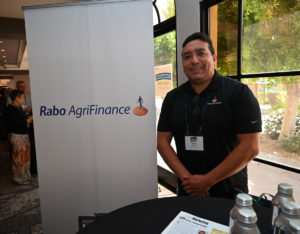 “U.S. Agriculture’s Labor Crisis: Can It Be Fixed?” was the topic for the Ag Media Summit Newsmakers session last week, sponsored by Rabo AgriFinance.
“U.S. Agriculture’s Labor Crisis: Can It Be Fixed?” was the topic for the Ag Media Summit Newsmakers session last week, sponsored by Rabo AgriFinance.
David Magaña, RaboResearch Fresh Produce Analyst, gave some insights into the reduction of the agricultural labor force available due to a declining percentage of young people. “Obviously this has been a challenge for years for agriculture,” said Magaña. “On the supply side of labor, we’ve seen drastic changes in demographics in Mexico. The natality rate has drastically declined from an average of seven children per family in the ’70s, to close to two children per family nowadays.”
Learn more in this interview:
Interview with David Magaña, Rabo AgriFinance
Precision Ag News 8/9
New Cover Crop Survey Released
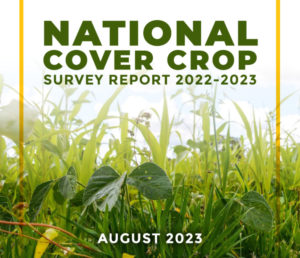 The 2022-2023 National Cover Crop Survey Report was released today the challenges assumptions on the role of incentive payments in cover crop adoption.
The 2022-2023 National Cover Crop Survey Report was released today the challenges assumptions on the role of incentive payments in cover crop adoption.
According to the survey, nearly half of the cover crop users participating in the survey reported receiving some sort of payment for cover crops in 2022, and almost 78% of cover crop non-users said incentive payments would be helpful. However, over 90 percent of the farmers who were receiving cover crop incentives reported that they would definitely or probably continue planting cover crops after the payments ended, while only 3.3% said they definitely or probably would drop cover crops at the end of the incentive program. Overall, less than 16% of cover crop users said receiving incentive payments was one of their goals for cover cropping.
“What the survey showed is that cover crop incentive payments are an important factor in encouraging and helping farmers to transition into cover cropping, but once they see the soil health improvements and other cover crop benefits, most stick with cover crop planting long after the incentives end,” said Dr. Rob Myers with USDA-NIFA North Central Sustainable Agriculture Research and Education (SARE) program and lead researcher for the survey.
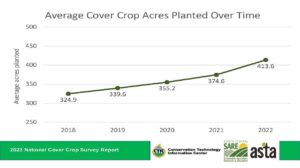 The 2022-2023 report marks the seventh National Cover Crop Survey, issued jointly by SARE, Conservation Technology Information Center (CTIC) and the American Seed Trade Association (ASTA), based on insights from nearly 800 farmers in 49 states. The survey series started in 2012, and data from the surveys has been used in academic research, educational programs, policy planning and even testimony to Congress.
The 2022-2023 report marks the seventh National Cover Crop Survey, issued jointly by SARE, Conservation Technology Information Center (CTIC) and the American Seed Trade Association (ASTA), based on insights from nearly 800 farmers in 49 states. The survey series started in 2012, and data from the surveys has been used in academic research, educational programs, policy planning and even testimony to Congress.
“The National Cover Crop Survey goes beyond acreage statistics by providing insights into what farmers want to achieve with cover crops, what motivates them to try and continue the process, how cover crops relate to other soil-building practices like no-till, and their approaches to using the practice,” says Ryan Heiniger, executive director of CTIC. “We are also just as interested in the perspectives of non-users of cover crops. Understanding their concerns and information needs provide direction for developing better outreach materials, and can help policymakers clear obstacles that hamper adoption or create more attractive incentives.”
Andy LaVigne, president and CEO of ASTA, adds that the survey provides seed producers with valuable insight on cover croppers’ needs. “Our members are extremely interested in learning about the needs of growers when it comes to which varieties they’re seeking and when and how they make cover crop planting decisions,” LaVigne says. “These perspectives help the seed industry plan ahead to ensure that farmers have the species they want as well as genetics that help them manage their cover crops effectively to achieve their goals.”
This was the first survey to explore livestock in cover crops, and it found 25% of respondents integrated livestock into their cover crop program. Of those who grazed cover crops, 76% reported a net increase in profit from the practice.
Get more details on the survey in this presentation with Heiniger, LaVigne, and Dr. Myers – read the full report.
2022-2023 Cover Crop Survey (39:06)
Interview with ASTA President and CEO Andy LaVigne
Cover Crop Survey interview with Andy LaVigne, ASTA (6:12)
Field Notes from Koch Agronomic Services – Episode 30
 The Field Notes podcast series from Koch Agronomic Services (KAS) breaks down the science and technology behind agronomy to help growers do more with less.
The Field Notes podcast series from Koch Agronomic Services (KAS) breaks down the science and technology behind agronomy to help growers do more with less.
Vital Tools in Range and Pasture Management
In this episode, we’re discussing pasture and range management with our KAS experts, Technical Agronomist, Lacie Thomas, and Territory Business Manager, Ryan Walker. They’ll address pasture management and the inputs needed to maximize yield potential and protect soil health on grazing land.
You can listen to the program here: Vital Tools in Range and Pasture Management 12:48)
And to make sure you don’t miss an episode, choose an option to subscribe
For Spotify on your computer download the desktop app
Livestock Publications Council Awards
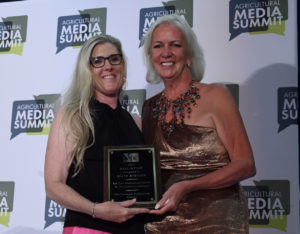 LPC’s Hall of Fame Award was Established in 1990, to honor distinguished livestock publishing leaders. Presenting the award to Diane Johnson is Molly Schoen, Charolais Journal.
LPC’s Hall of Fame Award was Established in 1990, to honor distinguished livestock publishing leaders. Presenting the award to Diane Johnson is Molly Schoen, Charolais Journal.
Diane Johnson, is no stranger the organization, having served more than 20 years as its executive director. During that time, she was a part of the development of the Ag Publications Summit which later became the Ag Media Summit. Diane was an integral part of 21 Ag Media Summit events including two Congresses held in the United States for the International Federation of Agriculture Journalists.
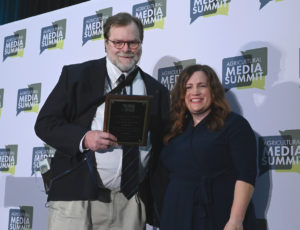 LPC’s Headliner Award Program, inaugurated in 1980, salutes an individual for meritorious service to the livestock industry. This year’s recipient is Dr. Bob Hough. Presenting the award is Katrina Huffstutler, Grant Company, LLC.
LPC’s Headliner Award Program, inaugurated in 1980, salutes an individual for meritorious service to the livestock industry. This year’s recipient is Dr. Bob Hough. Presenting the award is Katrina Huffstutler, Grant Company, LLC.
Hough has served the livestock industry in numerous capacities for almost 50 years but may be best known for his roles as chief executive office of the Red Angus Association of America and executive vice president of the North American Limousin Foundation.
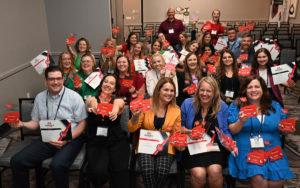 There are many more awards which you will be able to find a list of on on the LPC website. The Ed Bible Distinguished Service Award was presented to Tim Steinbeck, Modern Litho.
There are many more awards which you will be able to find a list of on on the LPC website. The Ed Bible Distinguished Service Award was presented to Tim Steinbeck, Modern Litho.




